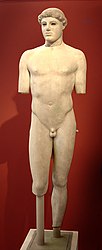S-curve (art)

In the visual arts, an S-curve is an "S"-shaped curve which serves a wide variety of compositional purposes. The term is usually applied to the standing human figure bending first one way and then back the other. It may also be applied more generally, for example in landscape painting.
In sculpture
In Ancient Greek and Roman sculpture, the S-curve is a traditional art concept where the figure's body and posture is depicted like a sinuous or serpentine manner. It is related to and is an extension of the art term of contrapposto which is when a figure is depicted slouching or placing one's weight and thus center of gravity to one side. However, the S Curve involves more of the body than the contrapposto, and is therefore considered to be a more advanced technical development. The "S Curve" concept was probably invented by the famous Greek sculptor Praxiteles, son of Kifissodotos, who lived in the 4th century BC.[1]
The Indian tribhanga ("three bend") pose is similar, but generally more pronounced, often with the neck also curved to one side. This goes back to at least 100 BC.[2]
The figura serpentinata is a variant or development of the pose. The term is usually applied only to art from the Renaissance onwards, and Donatello is often regarded as its inventor.[3]
Landscape
It can help guide the viewer's eye through the image to the main subject at the end of the curve, but can also serve as a subject in and of itself.[4] It has been variously described as dynamic,[5] feminine,[5] restful,[4] and hypnotic.[4] The S-curve is particularly prominent in a vertical composition, where it may be stacked to form a double S-curve for maximum effect.[5]
- Examples
-
Note that there is only a slight weight shift in the Kritios Boy; thus, it is a contrapposto.
-
An S-curve meanders into the distance in this photograph of a dirt path in the Palo Alto Baylands Nature Preserve
References
- ^ "Art Of Ancient Greece, Brief History (1050- 50 b.C.), Georgia Kokkorou- Aleyra
- ^ Craven, Roy C., Indian Art: A Concise History, p. 70, 1987, Thames & Hudson (Praeger in USA), ISBN 0500201463
- ^ The Metropolitan Museum of Art (2007). "Donatello (ca. 1386–1466)". The Metropolitan Museum of Art. Retrieved November 20, 2007.
- ^ a b c Taylor, David (21 February 2015). Understanding Composition: The Expanded Guide. East Sussex: Ammonite Press. p. 68. ISBN 9781781451083.
- ^ a b c Gallovich, Tom (2015). Power Composition for Photography: Develop Your Artistic Eye. Buffalo: Amherst Media. p. 62. ISBN 9781608958474.



